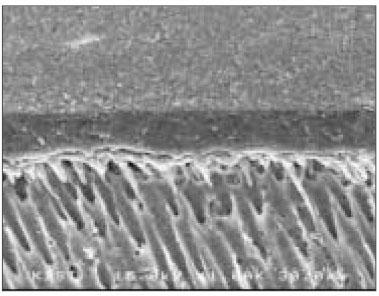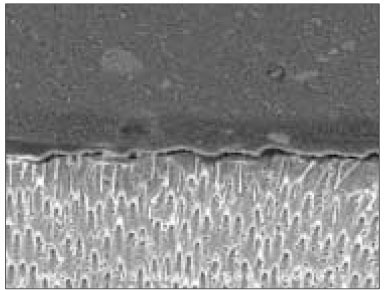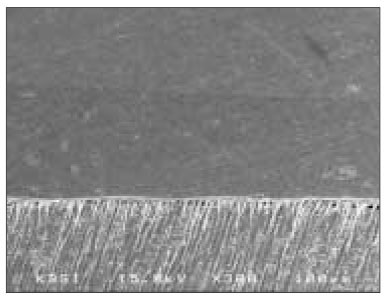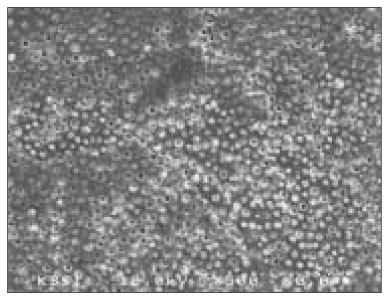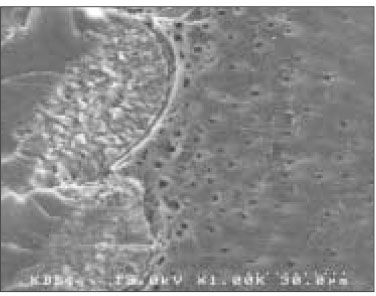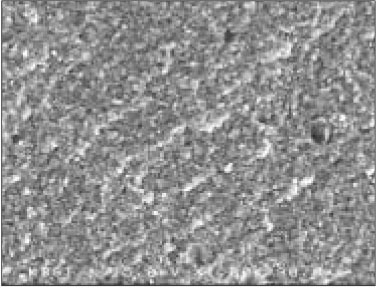J Korean Acad Conserv Dent.
2004 May;29(3):281-287. 10.5395/JKACD.2004.29.3.281.
The effect of adhesive property on microtensile bond strength to human dentin
- Affiliations
-
- 1Department of Conservative Dentistry, College of Dentisty, Pusan National University, Korea. bhur@pusan.ac.kr
- KMID: 1987104
- DOI: http://doi.org/10.5395/JKACD.2004.29.3.281
Abstract
- The purposes of this study were to evaluate the effect of adhesive property on microtensile bond strength and to determine the failure mode. Flat occlusal dentin surfaces were prepared using low-speed diamond saw. The dentin was etched with 37% phosphoric acid. The following adhesives were applied to the etched dentin to manufacturer's directions; Scotchbond Multi-Purpose in group SM, Prime&Bond NT in group NT, Scotchbond Multi-Purpose followed by Tetric-flow in group TR. After adhesive application, a cylinder of resin-based composite was built up on the occlusal surface. Each tooth was sectioned vertically to obtain the 1 x 1mm2 "sticks". Microtensile bond strength were determined. Each specimen was observed under stereomicroscope and scanning electron microscope (SEM) to examine the failure mode. Data were analyzed using one way ANOVA. The results of this study were as follows; 1. The microtensile bond strength value were; group SM (18.98 +/- 3.01MPa), group NT (16.01 +/- 4.82MPa) and group TR (17.56 +/- 3.22MPa). No significant statistical differences were observed among the groups (P>0.05). 2. Most of specimens showed mixed failure. In group TR, there was a higher number of specimens showing areas of cohesive failure in resin.
Keyword
Figure
Reference
-
1. Carvalho RM, Pereira JC, Yoshiyama M, Pashley DH. A review of polymerization contraction: the influence of stress development versus stress relief. Oper Dent. 1996. 21(1):17–24.2. Perdigao J, Lambrechts P, Van Meerbeek B, Braem M, Yildiz E, Yucel T, Vanherle G. The interaction of adhesive systems with human dentin. Am J Dent. 1996. 9(4):167–173.3. Swift EJ Jr, Perdigao J, Heymann HO. Bonding to enamel and dentin: a brief history and state of the art,1995. Quintessence Int. 1995. 26(2):95–110.4. Davidson CL, de Gee AJ, Feilzer A. The competition between the composite-dentin bond strength and the polymerization contraction stress. J Dent Res. 1984. 63(12):1396–1399.
Article5. Braga RR, Cesar PF, Gonzaga CC. Tensile bond strength of filled and unfilled adhesives to dentin. Am J Dent. 2000. 13(2):73–76.6. Kemp-Scholte CM, Davidson CL. Marginal sealing of curing contraction gaps in Class V composite resin restorations. J Dent Res. 1988. 67(5):841–845.
Article7. Feilzer AJ, De Gee AJ, Davidson CL. Setting stress in composite resin in relation to configuration of the restoration. J Dent Res. 1987. 66(11):1636–1639.
Article8. Kemp-Scholte CM, Davidson CL. Complete marginal seal of Class V resin composite restorations effected by increased flexibility. J Dent Res. 1990. 69(6):1240–1243.
Article9. Unterbrink GL, Liebenberg WH. Flowable resin composites as "filled adhesives": literature review and clinical recommendations. Quintessence Int. 1999. 30(4):249–257.10. Swift EJ Jr, Triolo PT Jr, Barkmeier WW, Bird JL, Bounds SJ. Effect of low-viscosity resins on the performance of dental adhesives. Am J Dent. 1996. 9(3):100–104.11. Van Meerbeek B, Willems G, Celis JP, Roos JR, Braem M, Lambrechts P, Vanherle G. Assessment by nanoindentation of the hardness and elasticity of the resin-dentin bonding area. J Dent Res. 1993. 72(10):1434–1442.
Article12. Labella R, Lambrechts P, Van Meerbeek B, Vanherle G. Polymerization shrinkage and elasticity of flowable composites and filled adhesives. Dent Mater. 1999. 15(2):128–137.
Article13. Tani C, Itoh K, Hisamitsu H, Wakumoto S. Effect of filler content on bonding efficacy of 4-META MMA/TBB bonding agent. Dent Mater J. 1994. 13(2):131–137.
Article14. Nakabayashi N. Dentinal bonding mechanisms. Quintessence Int. 1991. 02. 22(2):73–74.15. Kanca J. Effect of resin primer solvents and surface wetness on resin composite bond strength to dentin. Am J Dent. 1992. 5(4):213–215.16. Bayne SC, Thompson JY, Swift EJ Jr, Stamatiades P, Wilkerson M. A characterization of first-generation flowable composites. J Am Dent Assoc. 1998. 129(5):567–577.
Article17. Rada RE. The versatility of flowable composites. Dent Today. 1998. 04. 17(4):78–83.18. Montes MA, de Goes MF, da Cunha MR, Soares AB. A morphological and tensile bond strength evaluation of an unfilled adhesive with low-viscosity composites and a filled adhesive in one and two coats. J Dent. 2001. 29(6):435–441.
Article19. Eick JD, Welch FH. Polymerization shrinkage of posterior composite resins and its possible influence on postoperative sensitivity. Quintessence Int. 1986. 17(2):103–111.20. Gallo JR, Comeaux R, Haines B, Xu X, Burgess JO. Shear bond strength of four filled dentin bonding systems. Oper Dent. 2001. 26(1):44–47.21. Miyazaki M, Ando S, Hinoura K, Onose H, Moore BK. Influence of filler addition to bonding agents on shear bond strength to bovine dentin. Dent Mater. 1995. 11(4):234–238.
Article22. Abdalla AI, Davidson CL. Shear bond strength and microleakage of new dentin bonding systems. Am J Dent. 1993. 6(6):295–298.23. Fortin D, Swift EJ Jr, Denehy GE, Reinhardt JW. Bond strength and microleakage of current dentin adhesives. Dent Mater. 1994. 10(4):253–258.
Article24. Frankenberger R, Lopes M, Perdigao J, Ambrose WW, Rosa BT. The use of flowable composites as filled adhesives. Dent Mater. 2002. 18(3):227–238.
Article25. Giannini M, Carvalho RM, Martins LR, Dias CT, Pashley DH. The influence of tubule density and area of solid dentin on bond strength of two adhesive systems to dentin. J Adhes Dent. 2001. 3(4):315–324.26. Marshall GW Jr, Marshall SJ, Kinney JH, Balooch M. The dentin substrate: structure and properties related to bonding. J Dent. 1997. 25(6):441–458.
Article27. Phrukkanon S, Burrow MF, Tyas MJ. The effect of dentine location and tubule orientation on the bond strengths between resin and dentine. J Dent. 1999. 27(4):265–274.
Article28. Sano H, Shono T, Sonoda H, Takatsu T, Ciucchi B, Carvalho R, Pashley DH. Relationship between surface area for adhesion and tensile bond strength--evaluation of a micro-tensile bond test. Dent Mater. 1994. 10(4):236–240.
Article29. Phrukkanon S, Burrow MF, Tyas MJ. The influence of cross-sectional shape and surface area on the microtensile bond test. Dent Mater. 1998. 14(3):212–221.
Article30. Armstrong SR, Keller JC, Boyer DB. The influence of water storage and C-factor on the dentin-resin composite microtensile bond strength and debond pathway utilizing a filled and unfilled adhesive resin. Dent Mater. 2001. 17(3):268–276.
Article31. Bouillaguet S, Ciucchi B, Jacoby T, Wataha JC, Pashley D. Bonding characteristics to dentin walls of class II cavities, in vitro. Dent Mater. 2001. 17(4):316–321.
Article32. Nunes MF, Swift EJ, Perdigao J. Effects of adhesive composition on microtensile bond strength to human dentin. Am J Dent. 2001. 14(6):340–343.33. Perdigao J, Swift EJ Jr, Gomes G, Lopes GC. Bond strengths of new simplified dentin-enamel adhesives. Am J Dent. 1999. 12(6):286–290.34. Kanca J 3rd. One step bond strength to enamel and dentin. Am J Dent. 1997. 10(1):5–8.35. Figueiredo Reis A, Giannini M, Ambrosano GM, Chan DC. The effects of filling techniques and a low-viscosity composite liner on bond strength to class II cavities. J Dent. 2003. 31(1):59–66.
Article
- Full Text Links
- Actions
-
Cited
- CITED
-
- Close
- Share
- Similar articles
-
- Effect of moisture and drying time on the bond strength of the one-step self-etching adhesive system
- The effect of dentin desensitizers and Nd:YAG laser pre-treatment on microtensile bond strength of self-adhesive resin cement to dentin
- The effect of multiple application on microtensile bond strength of all-in-one dentin adhesive systems
- Influence of air abrasion and different dentin sealing techniques on microtensile bond strength to dentin
- Effect of a desensitizer on microtensile bond strength of different adhesives

